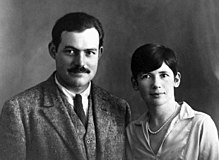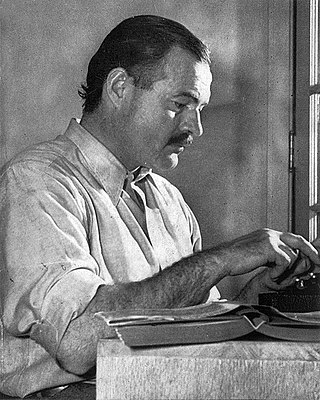
Ernest Miller Hemingway was an American novelist, short-story writer and journalist. Known for an economical, understated style that influenced later 20th-century writers, he has been romanticized for his adventurous lifestyle and outspoken, blunt public image. Some of his seven novels, six short-story collections and two non-fiction works have become classics of American literature, and he was awarded the 1954 Nobel Prize in Literature.

A Moveable Feast is a memoir by Ernest Hemingway about his years as a struggling expatriate journalist and writer in Paris during the 1920s. It was published posthumously in 1964. The book chronicles Hemingway's first marriage to Hadley Richardson and his relationships with other cultural figures of the Lost Generation in interwar France.

The Sun Also Rises is the first novel by the American writer Ernest Hemingway. It portrays American and British expatriates who travel from Paris to the Festival of San Fermín in Pamplona and watch the running of the bulls and the bullfights. An early modernist novel, it received mixed reviews upon publication. Hemingway biographer Jeffrey Meyers writes that it is now "recognized as Hemingway's greatest work" and Hemingway scholar Linda Wagner-Martin calls it his most important novel. The novel was published in the United States in October 1926 by Scribner's. A year later, Jonathan Cape published the novel in London under the title Fiesta. It remains in print.
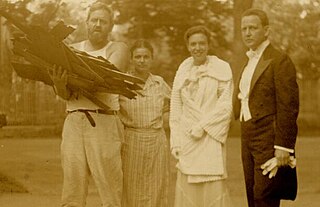
Waldo Peirce was an American painter, who for many years reveled in living the life of a bohemian expatriate.
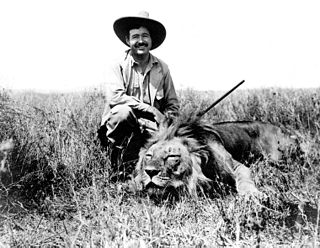
"The Snows of Kilimanjaro" is a short story by American author Ernest Hemingway first published in August 1936, in Esquire magazine. It was republished in The Fifth Column and the First Forty-Nine Stories in 1938, The Snows of Kilimanjaro and Other Stories in 1961, and is included in The Complete Short Stories of Ernest Hemingway: The Finca Vigía Edition (1987).
"Hills Like White Elephants" is a short story by Ernest Hemingway. It was first published in August 1927, in the literary magazine transition, then later in the 1927 short story collection Men Without Women. Later the story was adapted for film in 2002. "Hills Like White Elephants" is a short 38-minute film; British actor Greg Wise played The American.

The Complete Short Stories of Ernest Hemingway: The Finca Vigía Edition, is a posthumous collection of Ernest Hemingway's short fiction, published in 1987. It contains the classic First Forty-Nine Stories as well as 21 other stories and a foreword by his sons.

Men Without Women (1927) is the second collection of short stories written by American author Ernest Hemingway. The volume consists of 14 stories, 10 of which had been previously published in magazines. It was published in October 1927, with a first print-run of approximately 7,600 copies at $2.

Winner Take Nothing is a 1933 collection of short stories by Ernest Hemingway. Hemingway's third and final collection of stories, it was published four years after A Farewell to Arms (1929), and a year after his non-fiction book about bullfighting, Death in the Afternoon (1932).

Elizabeth Hadley Richardson was the first wife of American author Ernest Hemingway. The two married in 1921 after a courtship of less than a year, and moved to Paris within months of being married. In Paris, Hemingway pursued a writing career, and through him Richardson met other expatriate American and British writers.

"Cat in the Rain" is a short story by American author Ernest Hemingway (1899-1961), first published by Boni & Liveright in 1925 in the short story collection In Our Time. The story is about an American husband and wife on vacation in Italy. Critical attention focuses chiefly on its autobiographical elements and on Hemingway's "theory of omission".
"In Another Country" is a short story by American author Ernest Hemingway. It was published in Hemingway's 1927 short story collection, Men Without Women. The story deals with WWI soldiers receiving treatment in Italy during the war.
"Now I Lay Me" is a short story by American author Ernest Hemingway, the title is taken from the prayer above. It is one of Hemingway's Nick Adams stories and part of Hemingway's collection of short stories titled Men Without Women, which was published in 1927.
"Up in Michigan" is a short story by American writer Ernest Hemingway, written in 1921 and revised in 1938. It is collected in Three Stories and Ten Poems (1923) and The Fifth Column and the First Forty-Nine Stories (1938).

"Indian Camp" is a short story written by Ernest Hemingway. The story was first published in 1924 in Ford Madox Ford's literary magazine Transatlantic Review in Paris and republished by Boni & Liveright in Hemingway's first American volume of short stories In Our Time in 1925. Hemingway's semi-autobiographical character Nick Adams—a child in this story—makes his first appearance in "Indian Camp", told from his point of view.
"Che ti dice la Patria?" is a short story by American author Ernest Hemingway set in Italy. The Italian title may be translated as "What does the homeland tell you?"

"Out of Season" is a short story written by Ernest Hemingway, first published in 1923 in Paris in the privately printed book, Three Stories and Ten Poems. It was included in his next collection of stories, In Our Time, published in New York in 1925 by Boni & Liveright. Set in Cortina d'Ampezzo, Italy, the story is about an expatriate American husband and wife who spend the day fishing, with a local guide. Critical attention focuses chiefly on its autobiographical elements and on Hemingway's claim that it was his first attempt at using the "theory of omission".

Grace Ernestine Hemingway was an American opera singer, music teacher, and painter. She was Ernest Hemingway's mother.
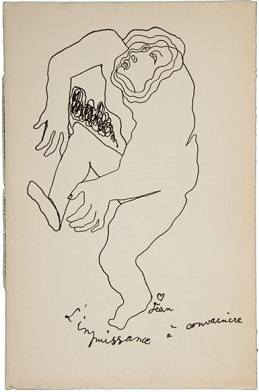
Today is Friday is a short, one act play by Ernest Hemingway. The play was first published in pamphlet form in 1926 but became more widely known through its subsequent publication in Hemingway's 1927 short story collection, Men Without Women. The play is a representation of the aftermath of the crucifixion of Jesus, in the form of a conversation between three Roman Soldiers and a Hebrew bartender. It is one of the few dramatic works written by Hemingway.
"A Pursuit Race" is a 1927 short story by American writer Ernest Hemingway. It was published in the collection Men Without Women.
